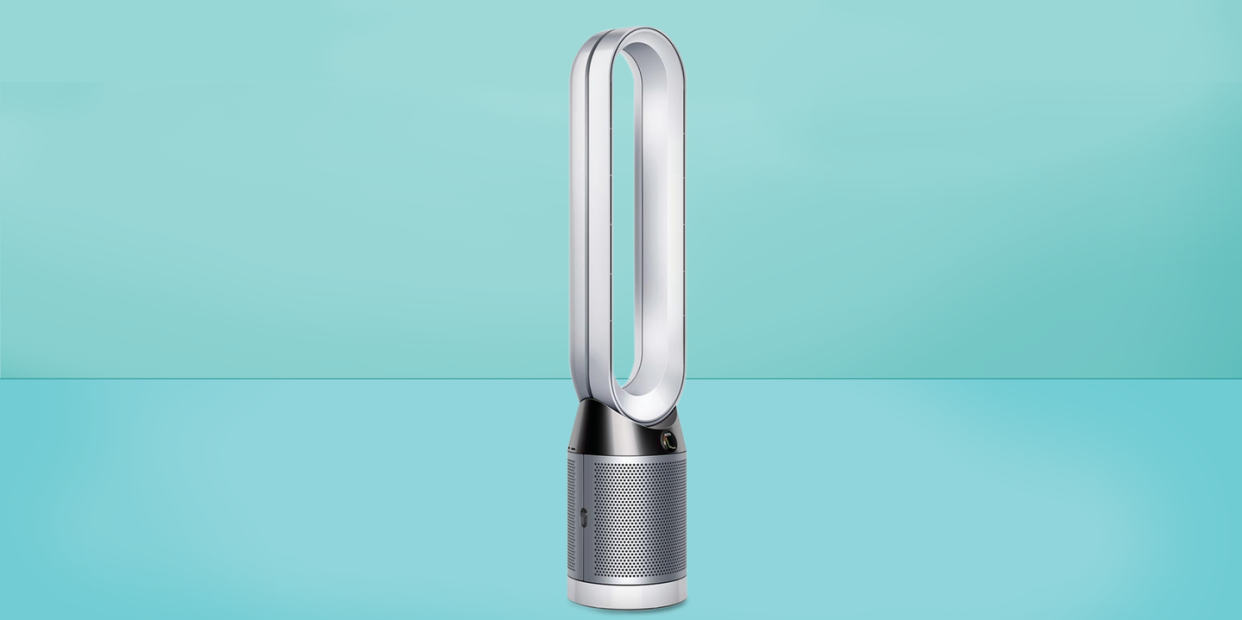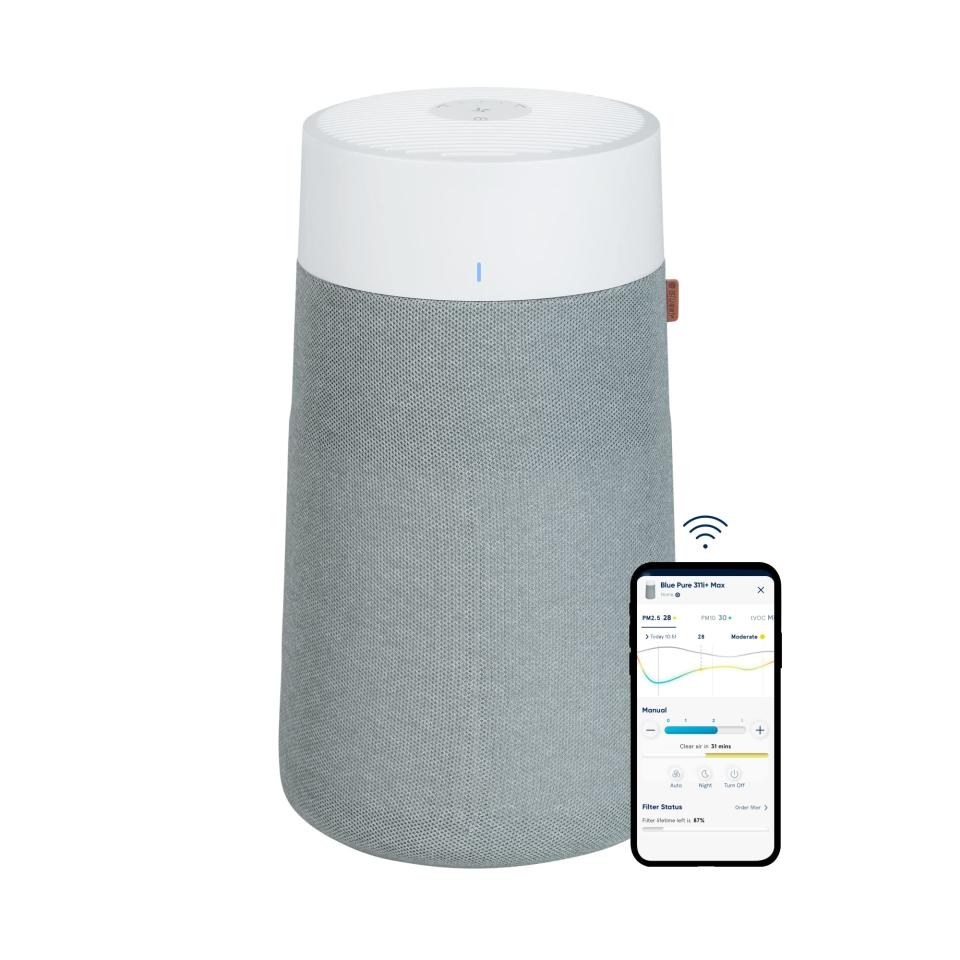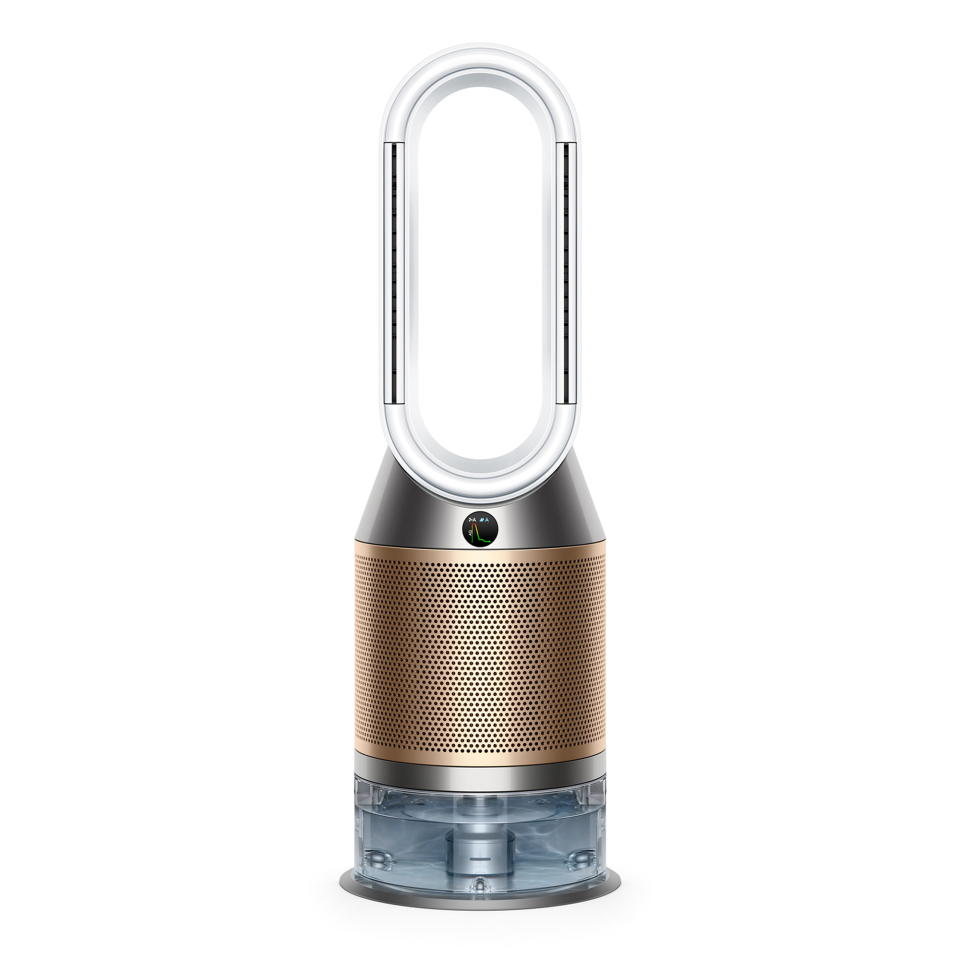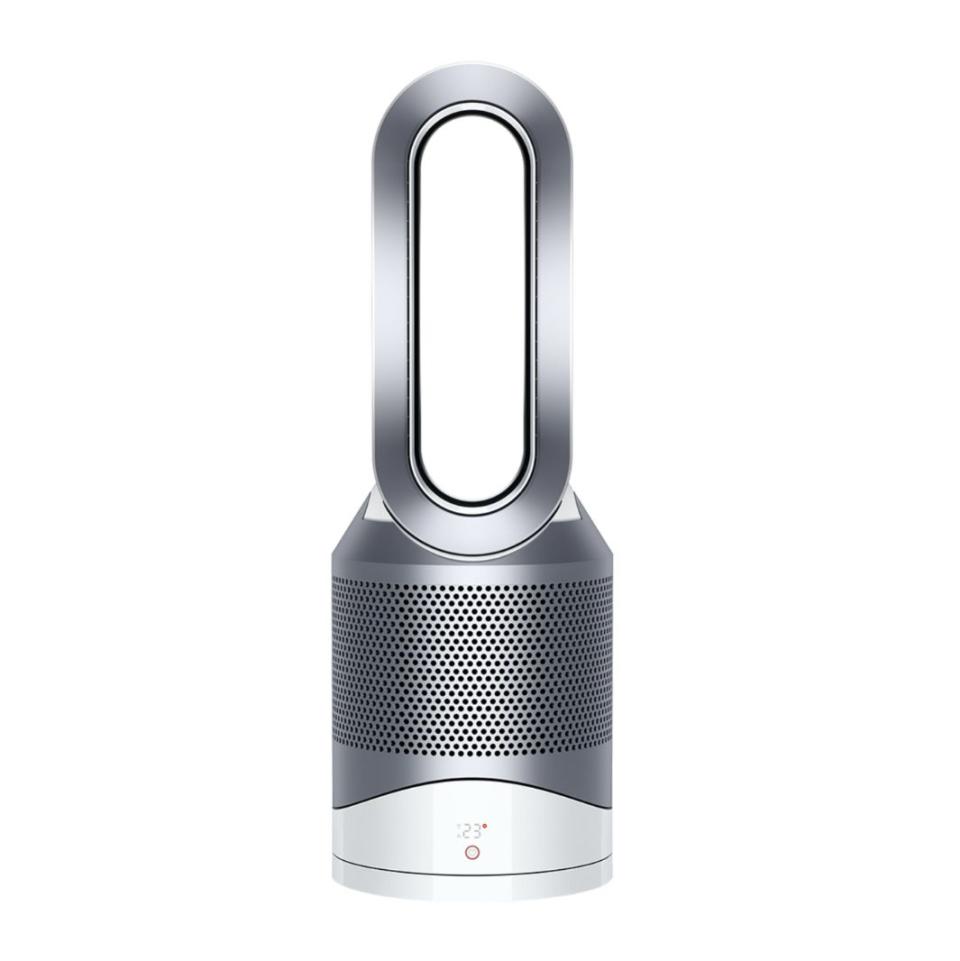9 Best Air Purifiers of 2023, According to Testing

"Hearst Magazines and Yahoo may earn commission or revenue on some items through these links."
We carefully reviewed this article in June 2023 and continue to stand by our top-rated picks.
In recent years, air purifiers have evolved from a mostly niche product to a must-have health and wellness device in many homes, thanks to the steady rise in indoor air pollutants — everything from to a pandemic-fueled uptick in households that own a pet to a recent case of wildfire smoke coming in from Canada and affecting multiple states in the U.S. We've included air purifiers with a true HEPA filter, which can remove microscopic particles found in wood smoke.
The surge in demand for air purifiers has brought more brands into the market, along with significant innovations. “Improved filtration helps today’s air purifiers capture more contaminants from the air in your home,” says Carolyn Forté, executive director of the Good Housekeeping Institute's Home Care and Cleaning Lab.
But some purifiers are better than others, according to our latest round of testing, which took our total number of reviewed models up to 45. Testing takes place in labs at the Institute and in consumer testers' homes, allowing us to evaluate the devices in real-world conditions. While an air purifier's ability to remove contaminants is the most important criterion, our experts also consider such factors as ease of use, maintenance and operating costs, the same way we do with other air treatment equipment, like humidifiers, portable air conditioners and dehumidifiers.
Keep in mind that an air purifier on its own can’t give your home perfect indoor air quality (IAQ). But when combined with IAQ best practices — like regular vacuuming and controlling indoor humidity levels throughout the year — the following top-rated air purifiers can help make your home healthier.
Our top picks:
Once you’ve read our reviews, you can find details on how we test air purifiers, plus everything you need to know when choosing the best model for your home, at the bottom of this guide. And be sure to check out even more ways to control allergens and air irritants in your home, including using a top-rated dehumidifier to remove moisture from muggy summer air.
Blue Pure 311i+ Max
To effectively capture all the contaminants floating through indoor air, you need an air purifier with serious filtration. In our latest Lab tests, Blueair's newly released 311i+ Max took over the top spot thanks to its advanced multi-level protection against contaminants of all sizes — not just dander and pet hair, but also cooking fumes, dust mites and pollen. "It was exceptionally fast at clearing the air in our test chamber, plus it was among the quietest models, even on its higher fan speeds," says Good Housekeeping Institute Lab Assistant Nikolas Greenwald. For good measure, the device is certified by Quiet Mark, an outside organization that evaluates consumer products for sound.
The 311i+ Max's washable fabric pre-filter that encases the device (available in five colors) snags fur, dust and other large particles. Once air is pulled inside the device, it passes through a true HEPA filter that's designed to capture smaller particles down to .1 micron, the smallest of all tested air purifiers. That's enough to clear up to 99.97% of pet-generated pollutants across 465 square feet in under 13 minutes. "It's perfect for a family room or studio apartment," says Greenwald, adding that "larger spaces will be better served by one of our more powerful top picks." As for its feature set, our testers were impressed by the 311+Max's connectivity and smart phone app, which lets you monitor your home's air quality remotely. You can also program the air purifier to kick into standby mode when you leave the house and turn on when you're close to returning.

Blue Pure 311i+ Max
$292.43
amazon.com
BlueairMacro Pro
Chances are, you'll need more than one air purifier to manage the air quality throughout your whole house. If you're on a budget, you could buy three or four of these Dreos for the price of a single model from other top brands, without giving up much in the way of performance.
Like the top-rated Blueair, the Dreo uses three-stage filtration — a fabric pre-filter, a True HEPA filter and an odor-neutralizing carbon filter (though it's certified to capture particles down to .3 microns, compared with the .1 micron rating of the Blueair). In extensive home testing that took place over several weeks, the Dreo effectively vanquished odors and stale air. “It seems to have really freshened up the air in our basement apartment where we have a dog and lots of dust,” noted one tester. Another plus is the compact design won’t get in the way in smaller spaces.
One caveat: The Dreo was not the most intuitive air purifier in our tests, so non-techies might find it frustrating — at least at first. Some testers quibbled that the interface takes a little getting used to, but in time, most appreciated the bevy of modes, including three fan speeds and separate modes for sleep, turbo and auto, in which the purifier uses onboard sensors to make automatic adjustments based on current air quality conditions in the room.

Macro Pro
$119.99
amazon.com
DreoTrue HEPA Allergen Remover Air Purifier
This air purifier from Honeywell, another established brand in the home comfort space, uses a pre-filter and True HEPA filter to capture contaminants down to .3 microns.
The model line comes in five different sizes that target rooms ranging from small (75 square feet) to extra large (500 square feet). This mid-sized model, previously the brand's largest, claims to clean the air as often as five times an hour and remove up to 99.97% of airborne particles, including viruses.
Our product analysts highlighted the relatively low cost of the replacement filter, which you'll appreciate if you need to run more than one air purifier at the same time, or if there's a high level of pollution in the home, say, from pet hair, smoke or pollen.
Keep in mind that even the largest model only has a coverage area of 500 feet. So if you're looking to clear the air in a very large space, check out our winners with coverage areas in the 800 to 1,300 square feet range.
RELATED: 6 Best Air Purifiers for Allergies, Tested by Experts

True HEPA Allergen Remover Air Purifier
$211.10
amazon.com
HoneywellPurifier Humidify+Cool Formaldehyde
Close to $1,000 is a lot to spend on an air purifier, especially if you need multiple units throughout the home. But Dyson has proven itself splurge-worthy in other product categories, from cordless vacuums to hair dryers, and that’s what our experts found with its latest air purifier, the Dyson Humidify+Cool Formaldehyde.
Its unique catalytic filter combines with True HEPA filtration to vanquish contaminants down to .3 microns. It was one of the fastest models at reducing particulate matter in our test chamber. And beyond that, it even has humidifying and cooling capabilities to help keep spaces dry and comfortable too.
The Dyson also has one of the most sophisticated onboard air monitors we’ve seen on a purifier. It measures the presence of volatile organic compounds (VOCs), nitrogen dioxide and particulate matter and then relays the data, along with ambient temperature and humidity levels, to a sleek app. “The interface on the app is extremely intuitive and should give users a very clear picture of their home’s indoor air quality,” says Greenwald.
If you’re willing to spend this much on an air purifier, operating costs might not be an issue. But we’d be remiss not to mention that at $80 a pop, the Dyson’s replacement filter is up there with the most expensive. Plus there’s the $30 cleaning kit you’ll need to use a few times a year to keep the device running smoothly.
Last but not least, the air purifier is massive, standing 3 feet tall. If neither of those is a deal breaker for you, the Dyson Humidify+Cool Formaldehyde won’t disappoint when it comes to optimizing your home’s indoor air quality.

Purifier Humidify+Cool Formaldehyde
$919.99
walmart.com
DysonCore 400S Smart True HEPA Air Purifier
This Levoit air purifier stood out to our testers for its combination of value, performance and intelligent smart design. The unit’s three-stage filtration, including a True HEPA filter, helps it capture airborne pollutants down to .3 microns in rooms up to approximately 400 square feet.
"We also liked its built-in precision laser sensor, which accurately monitors particles in the room and auto-adjusts fan speeds as needed," says Greenwald. The purifier is incredibly quiet, operating at just 24 dB, which you’ll appreciate if it’s stationed in your bedroom. (One of our testers has been running the unit for several months in her home and says the light hum is quite peaceful at night.)
Then there are its smart capabilities, which we love, including Levoit's VeSync app, which allows you to monitor real-time air quality, view filter life and set schedules.

Core 400S Smart True HEPA Air Purifier
$219.99
amazon.com
Levoit75i Air Purifier
The Alen is the only other model in our roundup (along with the Blue Pure 211) that can capture contaminants down to .1 microns. It combines that advanced filtration with a powerful fan for massive cleaning power across 1,300 square feet.
Since so many homes these days have open-floor plans, design matters when it comes to choosing the best air purifier. This is one of the better-looking models to pass through our labs, with its sleek front panel available in six colors. The combination of peak performance and high design doesn't come cheap: Besides the steep upfront price, filter replacement costs are several times as much as other models.
One other note: Our safety experts point out that the Alen has an optional ionization setting designed to combat even more pollutants. We don’t recommend this feature on any air purifier since it can produce ozone, a lung irritant. But even without the use of the ionization setting, the Alen should capture plenty of dust, pollen, smoke and more, while looking good in the process.

75i Air Purifier
$808.00
wayfair.com
AlenPure Hot+Cool Air Purifier
In a tight space, you don't want to create clutter by keeping an air purifier next to a space heater (during cool weather) or a fan (come summer). That's why our experts love this Dyson.
The triple-duty machine is a heater, fan and air purifier all in one. Using a True HEPA filter, this Dyson air purifier claims to clear up to 99.97% of airborne pollutants, including smoke from wildfires, as well as various odors and toxins. Our ease-of-use tests also found a bunch of family-friendly extras on the unit. Unlike other fans, it has no accessible blades, so it's safer for small hands. There's also a nighttime mode and a sleep timer as part of its 10-speed settings.
In terms of intelligence, the unit syncs with Amazon Alexa through your Echo device and can also deliver real-time air quality reports through the Dyson app. The Dyson is another top pick that will appeal most to tech-savvy users, as some of our testers found the controls a tad confusing. Take that into consideration if you're not a true gadget geek.

Pure Hot+Cool Air Purifier
$448.99
amazon.com
DysonAirmega 200M True HEPA
Our experts say this Coway is one of the best air purifiers for owners of heavy-shedding or smelly pets. It rivals our top-ranking BlueAir for performance, though it fell short of the winner's circle due to its less-than-average coverage area (361 square feet versus the 540 square feet of the Blue Pure).
The Airmega's four-stage filtration system includes an activated-carbon layer that’s designed to capture odors, including those from a beloved — yet stinky — pet. Our testers also like the easy-to-clean pre-filter, which captures hair, fur and other large particulates before they reach the inner HEPA filters. Indicator lights give the heads up when filters need to be cleaned or replaced.
RELATED: 6 Best Air Purifiers for Pets, Tested by Experts

Airmega 200M True HEPA
$197.00
walmart.com
Coway3-in-1 Sound Machine, Air Purifier and Nightlight
Fridababy, a company known for smart solutions to everyday parenting problems, recently introduced a small-room air purifier designed for spaces up to 150 square feet — like a baby's nursery. It's on our recommended list because, not only is it meant to help filter out dust mites and the like, but it also has a built-in sound machine and nightlight.
We’re all about finding space-saving, multi-purpose products, particularly for our little ones! While we have yet to review company testing data on the single-filtration air purity claims, we found the sound machine and nightly aspects easy to use and the filter easy to replace. However, it's not as durable (it weighs in at 1 pound, compared with the 10 to 30 pounds of more solidly built machines), so you'll want to handle it gently, which should be easier to manage in a quiet, low-traffic nursery.

3-in-1 Sound Machine, Air Purifier and Nightlight
$59.97
amazon.com
FridababyHow we choose the best air purifiers
Our product experts start by surveying the current marketplace to identify the best air purifiers that you’re most likely to find at stores and online. We also attend trade shows and industry events, like the Consumer Electronics Show (CES) to stay on top of the latest innovations in indoor air quality.
Next, we identify brands that have performed the best and proved the most reliable through more than a decade of air purifier testing at the Good Housekeeping Institute. We also consider newer brands with unique features or innovations.
Based on an extensive preliminary review of technical data, including claimed coverage area and type of filtration, our review team selected various 2023 models for hands-on testing, which took place both in our Lab and homes, the latter allowing us to test how they performed in real-world conditions. Controlled Lab tests measured an air purifier's ability to capture specific contaminants, such as smoke and other VOCs (volatile organic compounds). At-home testing checks for general improvement of freshness, as well as overall usability.
Our consumer testers measure factors like ease of setup, intuitiveness of controls and how uncomplicated it is to locate and replace the filter (or clean it, when applicable). Following the combined 50-plus hours of data review, Lab testing and at-home evaluations, we arrived at our list of best air purifiers out of 45 reviewed models.

As part of our 2023 air purifier tests, experts closely evaluated the filtration systems, including the type of materials used and how easy each filter was to replace. Models with multi-stage purification, including a True HEPA filter, were best at capturing airborne pollutants.

How to choose the best air purifier for your home
To zero in on the ideal air purifier for your needs, weigh the following factors:
✔️ Coverage area. Manufacturers typically list how much square footage a purifier is designed to cover. You might see multiple areas listed, say, one for the coverage provided in one hour and another for the coverage provided in five hours. Our experts recommend paying attention to the lower number since you'll likely want a device that delivers quick purification.
✔️ Filtration. Most top-performing air purifiers use mechanical filters with a dense web of fine fibers that trap particles from the air as it is pushed through by a fan.
True HEPA filters use a very fine mesh certified to capture 99.97% of particles measuring at least 0.3 microns (and in some cases down to 0.1 microns) in diameter. Our bottom-line advice is that the best cleaning power comes from a True HEPA filter.
"HEPA-like" filters have not been certified to meet that standard. Some air purifiers also have a pre-filter designed to capture dust and other larger particulates. Our experts like this feature.
Other filtration technologies are harder to evaluate, including those that incorporate activated carbon and ultraviolet light. We don't test these technologies specifically, so we can't attest to their efficacy.
✔️ Operating costs. The main consideration here is the price of replacement filters, which can range from $20 or less to $100 and up. Since you might need to replace the filters a few times a year, depending on your home's air quality, the expense can add up. Some air purifiers also have special cleaning kits designed to eliminate mineral build-up inside the machine, adding further to the operating costs.

Do air purifiers really work?
In short, yes, air purifiers work. In order to clean the air, these appliances use filters and fans to remove particles and circulate the purified air back into the room.
They can improve air quality and help you breathe easier. People suffering from allergies or asthma might find air purifiers with High-Efficiency Particulate Air (HEPA) filters particularly helpful because they remove common allergens and fine particles (99.97% of those measuring 0.3 microns in diameter in a lab setting, according to industry standards) from the air.
Not all air purifiers meet that high bar. For example, the much-hyped, sleek-looking IKEA Förnuftig can only capture 99.5% of smaller airborne particles. Even 2023 air purifiers that excel at removing particles like dust, smoke and pollen are limited in their ability to capture smaller toxins, such as those from cleaning products and paint.
One more thing to note: The effectiveness of air purifiers in real-world situations likely won’t mimic those of controlled conditions in a lab. That means it can be difficult to measure an air purifier’s true efficacy of how it will perform in your home.

Do air purifiers protect against smoke from wildfires?
Microscopic particles in smoke can trigger a range of health issues, from burning eyes to chronic lung disease, according to the U.S. Environmental Protection Agency, but "generally, outside pollution or smoke or temporary bad air isn't a constant concern for bystanders," says Ryan Roten, D.O., an emergency medicine doctor with Redlands Community Hospital in California. If you're still concerned, Dr. Roten notes that a HEPA filter-equipped purifier is once again your best bet: "Anything that has a True HEPA filter in it is probably adequate enough to filter out most of the large particles that would be concerning,” he says. "Most of the smoky smell will also be addressed as well."

Do air purifiers protect against COVID-19?
An air purifier with a HEPA filter will capture particulate matter down to the size of airborne viruses, including COVID-19. That’s why you often see manufacturers claiming their products remove 99% (or more) of particles in the air. Unfortunately, the science in 2023 simply isn’t clear enough on how quickly droplets containing the COVID-19 virus can be transmitted from person to person. That’s why our advice is to follow CDC guidelines for COVID protection, including getting vaccinated and wearing a mask indoors if you’re in an area of substantial or high transmission.

Are there any downsides to air purifiers?
Air purifiers are not a cure-all for every possible air quality issue. Yes, they can be part of your overall strategy. But they can become a disadvantage if they give you a false sense of security that keeps you from combating indoor pollution in other ways — for example, vacuuming regularly and running the kitchen range hood while cooking (or at least cracking a window to allow fumes to dissipate). It’s also critical to maintain and upgrade your home’s heating and cooling equipment. “[Whole-house] filtration is the easiest retrofit opportunity by installing high-capture filters in HVAC systems,” says Sam Rashkin, chief architect of the U.S. Department of Energy’s Building Technology’s Office.
Another possible concern is regarding air purifiers that use ionizers to help attract particles like static. In some cases, these purifiers can end up producing ozone in the process. While some manufacturers claim that the gas helps break down pollutants, it can also be a lung irritant and further aggravate asthma conditions. We continue to call on the industry to create stricter standards for this product category since these are situations in which the devices can cause more harm than good — for example, if the air purifier produces ozone, a known lung irritant.
If you're interested in buying an air cleaner that uses ionizers, make sure it meets the California Air Resources Board (CARB) limit of 50 parts per billion; the CARB website includes a list of approved air purifiers, and the information is usually listed in marketing material as well. For certified units with ionization, we still recommend that you operate the device with this function turned off until more research is done on the effectiveness and safety of these types of machines.

What you need to know about air purifier maintenance and operation
✔️ Cleaning: Apart from wiping down the housing every now and then, cleaning the exterior of the device is minimal. However, the filters that do the dirty work inside an air purifier require regular attention. Whether made of paper, fiber or mesh, the filters should usually be cleaned and/or replaced every few months or so (check the owner’s manual for specific recommendations). Some filters are reusable, but they require meticulous maintenance, so you don't usually find them on the most effective air purifiers. One exception is models with a washable pre-filter, designed to capture large particles before they reach the primary filter; this feature can cut operating costs by extending the life of the main inner filter.
✔️ Operation: For maximum air cleaning, you should run the air purifier all the time when you’re home. Our picks are all UL-certified for safety, though as with any electrical device, be mindful of fire hazards like frayed wires. In areas where noise is a factor, like a bedroom, you could operate the machine on high when you’re out of the room, then drop it to a lower fan setting before going to sleep. It’s also best to keep windows and doors closed, so the unit isn’t cleaning the air from outside or other parts of the home. And make sure airflow to the device isn’t obstructed by furniture, curtains or other objects.

Why trust Good Housekeeping?
Dan DiClerico has extensively tested and written about air purifiers for over 20 years. He has also spearheaded numerous investigative reports on the topic of indoor air quality, working closely with outside experts from government, industry and the home services spaces. As director of the Home Improvement & Outdoor Lab at the Good Housekeeping Institute, Dan oversaw the latest round of air purifier testing in our labs and the continuous in-home, survey-based consumer testing that allows us to evaluate these devices in real-world conditions.
Rachel Rothman also brings extensive hands-on testing of air purifiers, leveraging her training in mechanical engineering and applied mathematics. In her role as chief technologist and director of engineering at the Institute, Rachel helped develop the test protocol for this category. With regard to indoor air quality, she is a leading advocate for the adoption of rigorous industry standards. Rachel has also tested dozens of air purifiers in recent years at her home on Long Island, NY.

You Might Also Like

